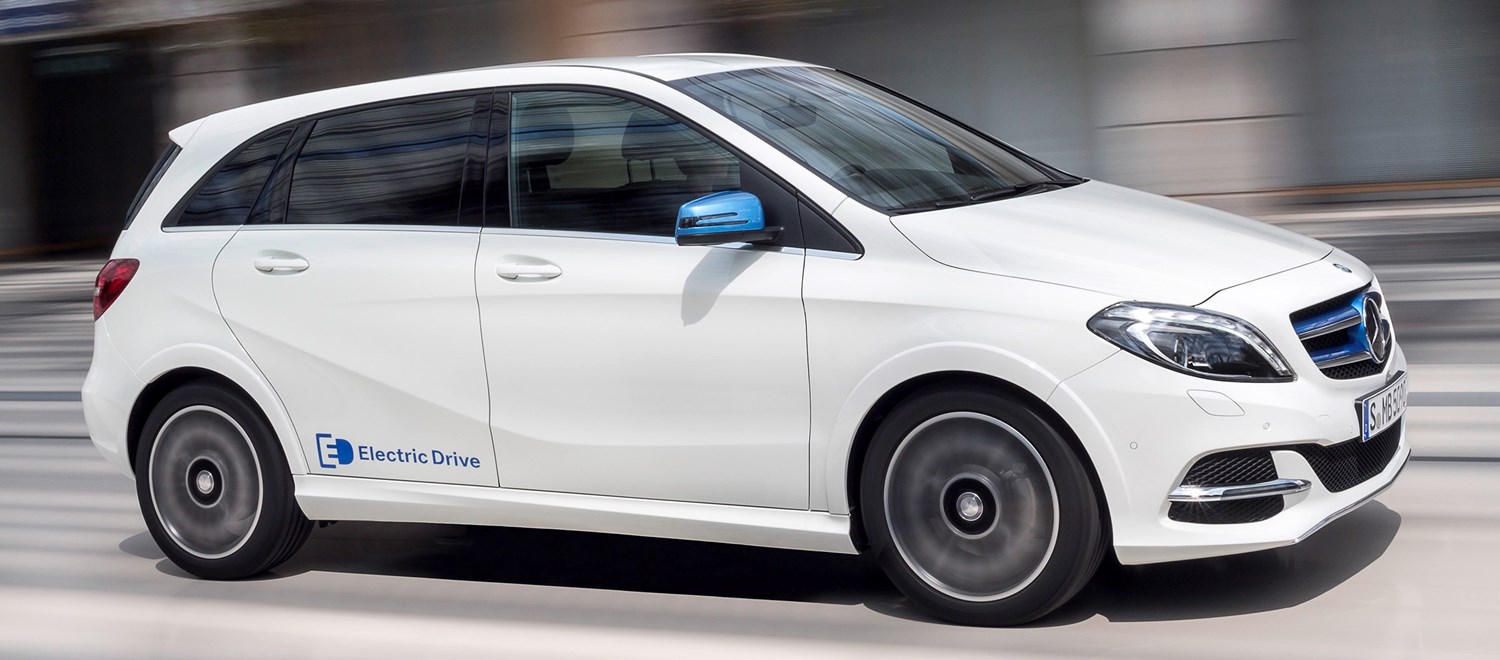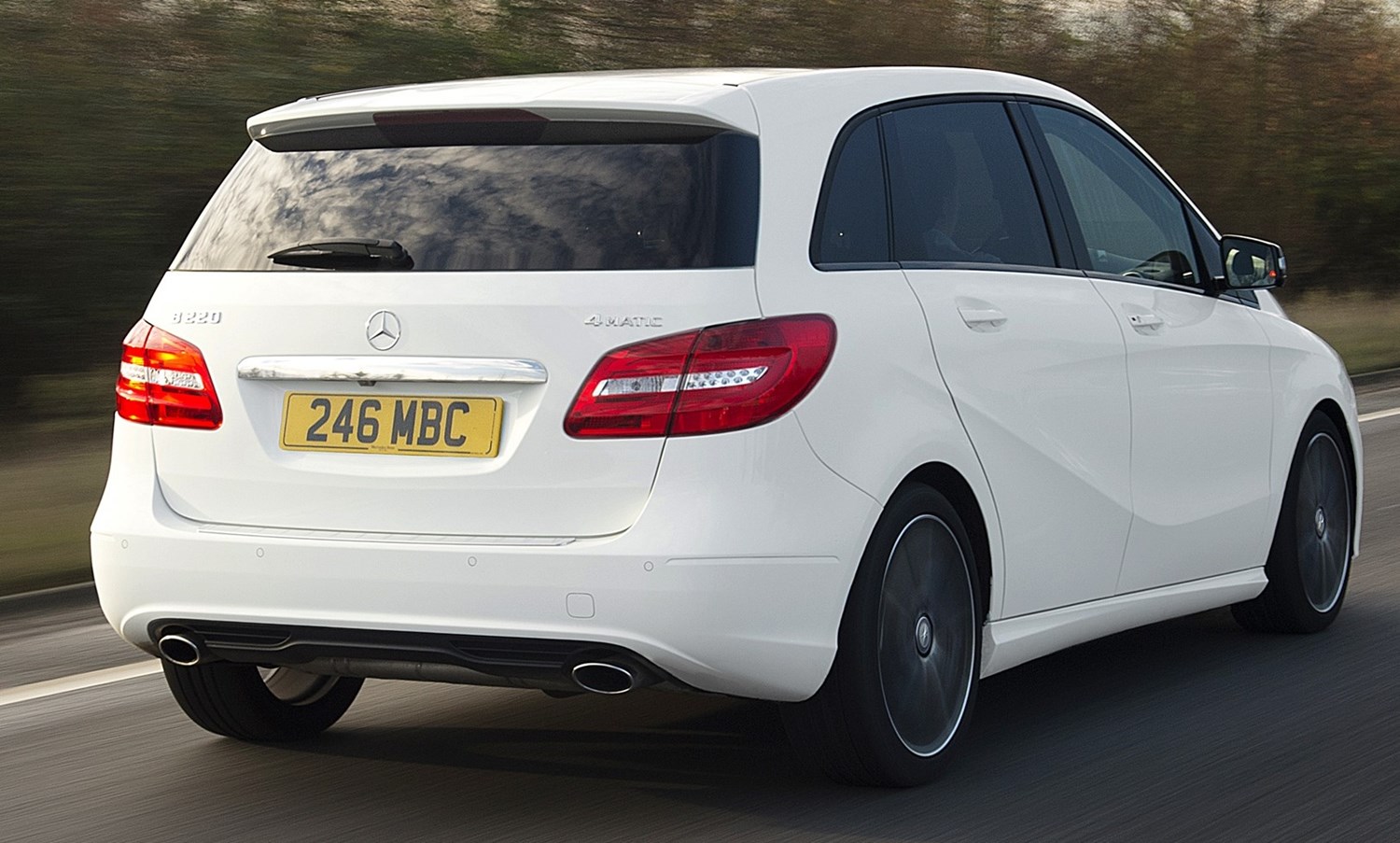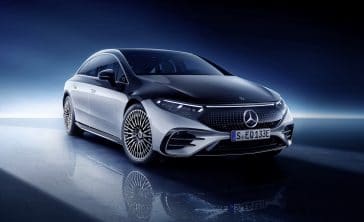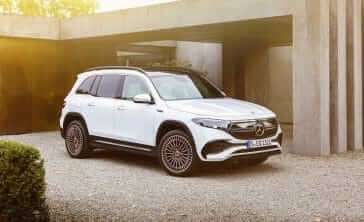Model review
Introduced in 2005, the B-Class is a small MPV which shares a lot of its architecture with Mercedes' smallest car, the A-Class.
The original car retained the famous 'sandwich' floor of the A-Class, a system designed to hold the heavy drivetrain components in such a position that they could slide under the passenger compartment in a heavy front impact. This gave the A-Class, and the B-Class too, a relatively stubby nose and a high-sided profile. The B-Class is even taller, giving plenty of passenger headroom.
When the A-Class changed for a more conventional design in 2011, the B-Class followed suit. It remained a taller version of the hatchback however. A facelift was introduced in 2015, to update the exterior to match newer Mercedes models.
The clearest rival for the B-Class is the BMW 2 Series Active Tourer, introduced in 2014. It uses a similar recipe of a front-wheel drive and taller version of the company's smallest conventional hatchback, and occupies a similar premium sector. Alternatives elsewhere include the Volkswagen Golf SV, Ford C-Max and Vauxhall Zafira.
Latest model
The current B-Class was introduced as a facelift to the second generation car in 2015. This brought minor changes to the interior – a larger navigation screen, for example – but the update focussed on making the exterior look more like Mercedes' other cars, particularly the A-Class and C-Class.
When it comes to specifications, it's the usual Mercedes fare of SE entry models, with Sport and AMG Line available as higher grades. The Electric Drive version sits as its own model, with Sport and Electric Art trim levels.
There's a limited selection of engines, with a 1.6-litre petrol in two versions, a 1.5-litre diesel, two versions of a 2.1-litre diesel and the electric option. All but the top B220d and Electric Drive cars are available in manual or automatic. The B220d is automatic only, with front or four-wheel drive, and the Electric Drive uses a single speed direct drive transmission.
That doesn't translate to a huge amount of performance, although the entry 1.5 diesel is the only really tardy option. Most cars break under 9 seconds for a 0-60mph run, while fuel economy for the diesels nudges 70mpg (or 104g/km).
Value for money
A basic B-Class – a manual-equipped B180 petrol in SE specification – will run you up a £22,895 bill. It's not a huge amount and covers most of the bases, with a 7-inch display, MP3 and USB connectivity, smartphone integration, air conditioning, keyless start and a reversing camera.
However, prices soon start to climb as you head up the grades. Sport adds nearly £1,000 and AMG Line around £1,300 again. An automatic will costs you £1,600. It sounds like a reasonable price to pay until you realise what isn't included.
Navigation is, for example, a £495 option on any grade. DAB radio? Not included with any trim, but a £430 option. By the time you've gone for a sensible car – a B200d with 7-speed auto – and added reasonable equipment like DAB, navigation and electrically adjustable front seats, you're up to £30,000.
That barely scratches the surface of the options list either. At least leather is standard though, and every B-Class has a huge array of safety kit.
Running costs shouldn't be too high either. All cars sit in low insurance groups, from 15 up to 24, and return decent fuel economy – the petrol models all record around 50mpg, the diesels nearer 70mpg. CO2 ratings are, particularly for the diesel, low enough to attract reasonably low road tax.
Looks and image
It seems harsh to say it, but Mercedes simply doesn't make a car as boring to look at as the B-Class. It's very much by necessity – it is, after all, a high-sided version of the entry level hatchback and there's not a great deal that can be done when it comes to styling with the required proportions.
None of its major rivals are lookers either, and at least the front and rear, which resemble the C-Class and old ML-Class respectively, show some effort.
Mercedes in general has an image of premium vehicles made to high standards, and the B-Class does little to dispel it with features like standard leather and a standard touchscreen.
It can be a little pricey to fix – despite vastly improved reliability since the early 2000s, Mercedes still finds some cars low down on reliability surveys as a result of the cost - so if you do find any problems it may leave a poor impression.
Space and practicality
Although the B-Class is very spacious and roomy, it's important to note that it's only a five-seater. Some cars of this kind can offer a third row of seats for occasional use, but the B-Class has no such option.
By not trying to force in additional seats, the B-Class manages 488 litres of boot space, rising to 1,547 litres with the back row of seats folded. This means that there's over a third more space in the boot than the A-Class it's based on.
The B-Class was tested by Euro NCAP in 2011 when the second generation model debuted. It scored a full five stars and, impressively, a 97% score for adult occupant safety. When you consider that every safety aid is standard on every B-Class, including eight airbags, adaptive brake assist, stability control, an emergency call system and emergency interior lighting, it's probably not a surprise.
Engines
There's a selection of six engines in the B-Class, with two petrol, three diesel and an electric alternative.
The first petrol option is a 1.6-litre, four-cylinder engine, dubbed the B180, which produces 120hp. It's enough to get the B-Class to 60mph in a reasonable 8.8 seconds (8.5s for the automatic), with a 124mph top speed. CO2 emissions sit at 129g/km, equivalent to 50.4mpg, with the automatic 2g/km and 0.2mpg better off.
An alternative version of this engine, called the B200, packs 154hp. It's notably quicker, with 60mph coming up after just 8 seconds and a 137mph top speed, but there's only a minor CO2 penalty and the B200 still returns 49.6mpg.
Diesels start with a 1.5-litre engine under the B180d name, which is actually a Nissan/Renault engine rather than a Mercedes unit. With 108hp, it's the slowest B-Class and takes 11.4 seconds to reach 60mph. The trade-off is a 104g/km CO2 rating and as much as 70.6mpg combined, depending on specification.
The B200d uses a 2.1-litre Mercedes engine. This has 134hp, which will see the car hit 60mph in 9.2s (8.7s for the automatic) and on to 130mph. It's not significantly worse on fuel though, and with the automatic gearbox it matches the 70.6mpg rating.
A third diesel is a variant of the same 2.1-litre unit, tuned to 175hp and named B220d. Hitting 60mph in 7.4 seconds with a 139mph top speed, it's the highest performance option. Fuel economy is barely worse, with 108g/km CO2 and 67.3mpg combined.
This is the only car available with 4MATIC four-wheel drive, although this puts a serious dent in the running cost credentials, slashing economy to 56.5mpg combined.
The Electric Drive, also known as the B250e, uses a 177hp electric motor powering the front wheels. Despite being 150kg heavier it still manages to hit 60mph in 7.7 seconds, and will run up to 99mph. It has a 124-mile range, increasing to 142 miles if you pick the Range Plus option.
Using a battery pack sourced from Tesla, the car will charge from empty in 2.5 hours if you have an appropriate 3-phase charger, or around 9 hours from 16 amp charging points.
Running costs
When it comes to day-to-day costs, the Electric Drive is the obvious choice. It's zero-rated for emissions, which means it qualifies for the very lowest road tax bands, and your refills are pennies on your electricity bill instead of pounds at the pumps.
The diesels are the pick for conventionally-fuelled cars though. Despite the performance differences, each will manage around 70mpg, with the automatics fractionally more frugal than the manuals. Exercise caution with the 4MATIC cars though, as the four-wheel drive system saps fuel – expect no better than 56mpg and probably under 50mpg in normal use.
Nevertheless, even the petrol cars are rated at around 50mpg, and this means that even the most expensive B-Class to run is only in the £200 first-year VED bracket. While it is possible to specify a B-Class to over £40,000, it won't be a consideration in almost all cases, so there are no worries about the extra £310 yearly VED that would bring.
Insurance costs ought to be reasonable. MPVs are typically inexpensive when it comes to insurance, and even though this is a Mercedes-Benz, every car is between group 15 and 24, even the Electric Drive. The bulk of the range is around group 19, with just the more powerful engines and higher specifications like AMG Line attracting higher groups.
Maintenance costs might be a wrinkle. Mercedes usually puts in a middling performance in reliability surveys not because they break but because they're expensive to fix if they do. The B-Class shares quite a few parts with the A-Class and GLA-Class (and Infiniti Q30/QX30), but these are low volume cars and the availability of parts in combination with the standards to which they're made may mean steep repair bills.
Things to look out for
By and large, the Mercedes B-Class is a picture of health. Small numbers of vehicles have been recalled for safety concerns regarding the seat belts and the rear seat back rests, so it's vital to check if your car is affected by and has had the necessary work required to correct these issues.
That aside, if buying second-hand you'll need to check the usual areas applicable to MPVs. These are cars that are used during rush hour to take kids to school and see the inside of many a public car park, so look out for parking dings, scrapes and shunts.
Be particularly aware that the short journeys these cars do are not compatible with the diesel engines many will buy – diesel particulate filters (DPF) need a good run to regenerate properly and cars used habitually over short distances may be prone to an expensive DPF failure.
Rivals
Where Mercedes leads, BMW will follow – and vice versa – so you only need look across to Munich to find the B-Class's most obvious rival. BMW's 2 Series Active Tourer bears a number of similarities to the B-Class, as it too is a front-wheel drive MPV based on the company's smallest regular hatchback.
The 2 Series has a few different engine options, offers four-wheel drive on some models and a plug-in hybrid (PHEV) instead of full electric – although on that front, the BMW i3 might also be considered a rival.
The only other obvious rival is the Volkswagen Golf SV. It has a relatively desirable badge and occupies the same class. Other rivals are more conventional and lack the premium brand – and price. Ford's C-Max, the Renault Scenic and Citroen C4 Picasso all have the same family car-based manners and 5-seat MPV practicality.
Depreciation warning
Don't hold on to any expectations that because this is a Mercedes for Volkswagen money, it's going to keep its value well. MPVs are cars of necessity rather than desire and residuals reflect this – 40% is about the best you can expect for retained value after three years, depending on mileage.
To some extent it's something you can moderate as a first owner, by picking the right options and avoiding the wrong ones. Don't skimp on the engine, avoid the manual gearbox and ensure that the car has DAB, satellite navigation and electric-adjustable front seats and you'll end up with a car that doesn't cost you too much in the first place and has what a second owner would expect.





